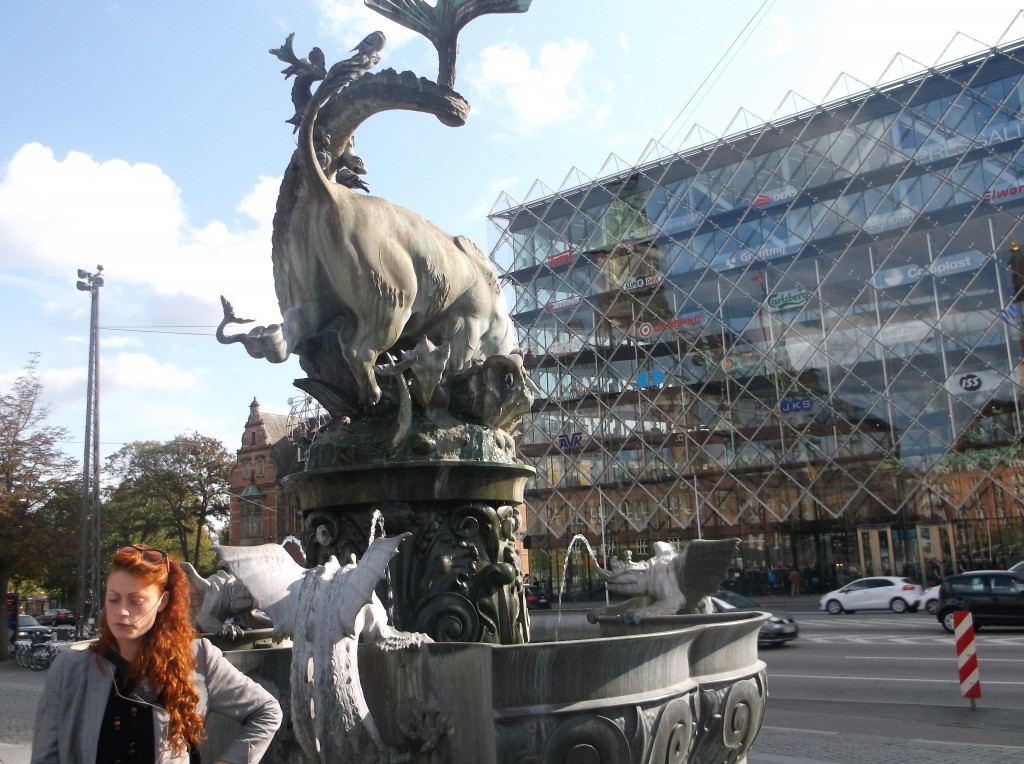Bianca Hermansen strutted into class with long red hair, buzzed on one side and a black dress that poured to her glamorous platform heels. You could see the confidence in her walk. I was her student in a class called Strategies of Urban Livability at the Danish Institute for Study Abroad in Copenhagen. On our first day of class she brought us outside and onto the streets. She stopped in the middle of the street and told us, “This is a shared street. Cars, motorcycles, bikes, and pedestrians all have to share this street, and no one has the right of way. Many people argue this is unsafe”. Then she smiled and said, “I will perform several tests to prove that wrong.”
The students scuttled closer to watch Bianca. She turned around, and began weaving through the crowd. As a bike approached, she suddenly spun around and lunged in front of the bike’s path. The bicyclist swerved and continued forward, but not after a brief glare and several muttered words. She turned around and asked, “Did you see that? Even after I purposefully blocked the bike, the bicyclists was skilled in maneuvering around me. People in shared streets are hyperaware of their surroundings, which actually makes these streets safe”. Bianca turned forward, and continued her test eight more times. Not once was she hit.
Bianca is the sort of person people gawk in awe from her actions and words. She is not afraid to be bold. Occasionally she even drops the f-bomb. Today, she is running her own research based urban design office, Cititek, in Copenhagen. One of the many things she does is consult with municipalities, cities, and private practices on how to design user-friendly cities. For example, she is developing the Strategic Cultural Plan in Larvick, Norway that will commit to user-driven design work. This means instead of plans being showcased on miniature plastic buildings and streets, they will be tested and prototyped in the city by involving the users or the local community.
Bianca’s work is driven by the principle that livable cities are inherently sustainable. Recently, I asked Bianca about methods for creating sustainable megacities. I asked, “How can megacities be sustainab–“. She brought her hand to her mouth and coughed to the side, “That’s fucking impossible”, she interrupted, “Sorry, continue”.
After reading books about sustainable megacities, I entered the conversation sure they were possible. So, I threw my assumptions aside and asked her if cities are more sustainable than rural settings.”Oh. There is no doubt about it”, she replied.”Collective systems are more efficient than individual systems”.
“Collective systems are more efficient than individual systems”.
She explained how working together is part of the culture in Scandinavia, and that is why Copenhagen is equipped to prepare for climate change.”We just have a long history of solving problems together because we have very few resources available”, she paused, “You know, we don’t have wild life, our soil is very scarce in terms of nutrients, our climate is shitty. We’ve had all odds against us. So we have learned at a very early age in our history that we needed to work together or we wouldn’t make it through the winter”.
Bianca’s argument that culture and history of a community drive climate-action decisions is unique. Her solutions for cities are not based around solar panels or electric cars, but rather, collective systems. The neat thing is that the collective systems culture can be built into the infrastructure of any city. So, designing built environments that inherently encourage people to live collectively is sustainable.
One way Copenhagen does this with its bike lanes. The lanes are the size of car lanes, and have more traffic as well. The blue painted lanes are protected by trees, parked bikes, or asphalt barriers. By designing safe and convenient bike lanes, people prefer biking over other modes of transport. This is the sort of culture that Bianca wants to bring to other cities, but which is not feasible for megacities.
The thing is, cities and megacities are very different. The key contrast is land size. Bianca explained that sustainable megacities are not possible with our current technology. The sheer size of megacities is impractical because we do not have affordable techniques to run them. There is a limit to the size of pipes, power of pumps, and even the frequency of a bus loop. With her index finger, she drew an imaginary bus route in the air and explained that a bus route depends on the distance from the beginning to end. As more land is used for a megacity, the bus route will get longer, and will take an hour or more to get from one location to another. That isn’t cost effective or convenient for people and the bus providers. Smaller is not always better, but it sure helps for sustainability.
This level of pragmatic thinking is the sort of thinking that makes Bianca different from other planners. She experiences a city as a user. Her designs are guided by human emotional, physical, and psychology responses. That is why she declared that “a sustainable city is a city”. A good city will need to address human and environmental needs. So, once human experience are core to city plans, cities will be transformed into livable and sustainable spaces.
“a sustainable city is a city”
Bianca is not slowing down a bit with her work. I asked Bianca what she hopes her legacy will be. She replied, “I’m more of a marathon, rather than a sprinter kind of person. It’s okay. It takes awhile. That’s totally fine, as long as we get it right. And we are going to get it right because I’ve made up my mind that we’re going to get it right. You’re getting there kicking and screaming, I’m going to fucking drag you there, you people”. With her boldness, I confident we will make great strides.
